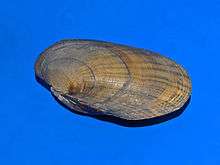Lampsilis siliquoidea
| Lampsilis siliquoidea | |
|---|---|
 | |
| Lampsilis siliquoidea on display at the Museo Civico di Storia Naturale di Milano | |
| Scientific classification | |
| Kingdom: | Animalia |
| Phylum: | Mollusca |
| Class: | Bivalvia |
| Order: | Unionoida |
| Family: | Unionidae |
| Genus: | Lampsilis |
| Species: | L. siliquoidea |
| Binomial name | |
| Lampsilis siliquoidea | |
| Wikimedia Commons has media related to Lampsilis siliquoidea. |
Lampsilis siliquoidea, also known as the Fatmucket Clam, is a species of freshwater bivalve in the Unionidae family.
Description
L. siliquoidea is recognized by its brown shell with dark rays, and is usually about 70 to 100 mm in size. The shape of the shell is oblong to elliptical, compressed or inflated, with uniform thickness. Fatmucket Clams are filter feeders. They feed on algae, phytoplankton, protozoans and organic particles. In the parasitic glochidial stage they feed on blood from hosts species, which include bass, perch, walleye, and sturgeon.
Distribution and habitat
It is widespread in North America, found in the drainages of both the Mississippi River from New York to Minnesota, the Great Lakes, and Hudson Bay. It lives in lakes, rivers, streams and quiet waters, usually on sandy-mud bottoms.
References
- Turgeon, D. D., A. E. Bogan, E. V. Coan, W. K. Emerson, W. G. Lyons, W. Pratt, et al. (1988) Common and scientific names of aquatic invertebrates from the United States and Canada: mollusks, American Fisheries Society Special Publication 16
- Turgeon, D. D., J. F. Quinn, Jr., A. E. Bogan, E. V. Coan, F. G. Hochberg, W. G. Lyons, et al. (1998) Common and scientific names of aquatic invertebrates from the United States and Canada: Mollusks, 2nd ed., American Fisheries Society Special Publication 26